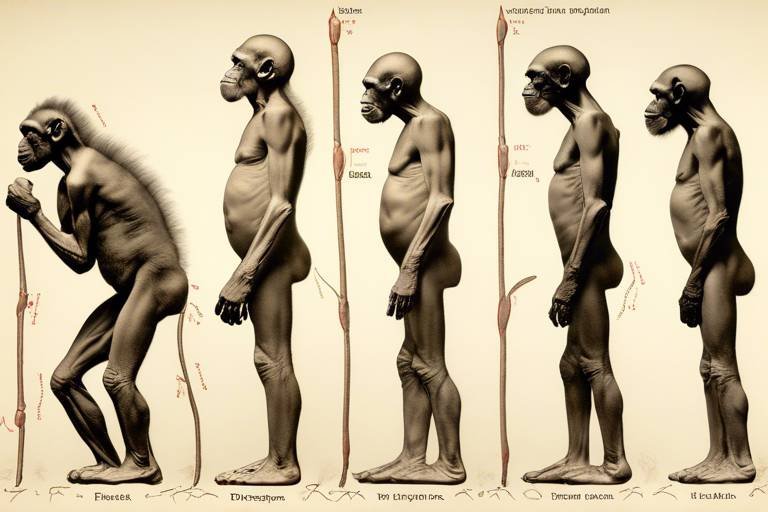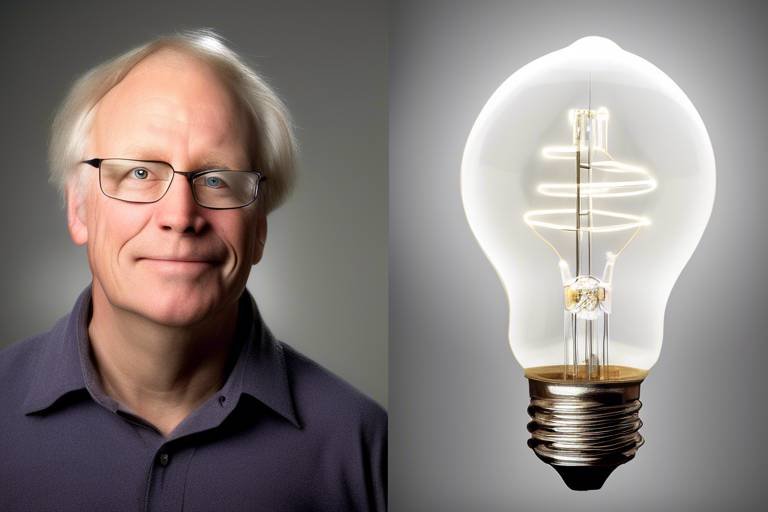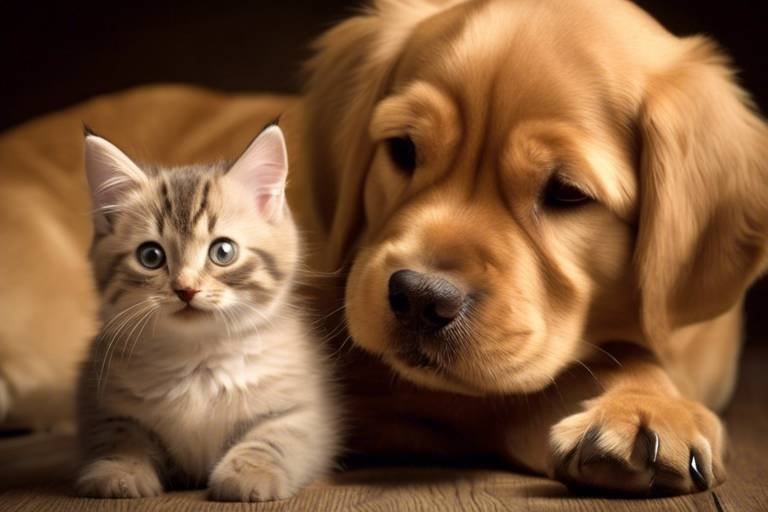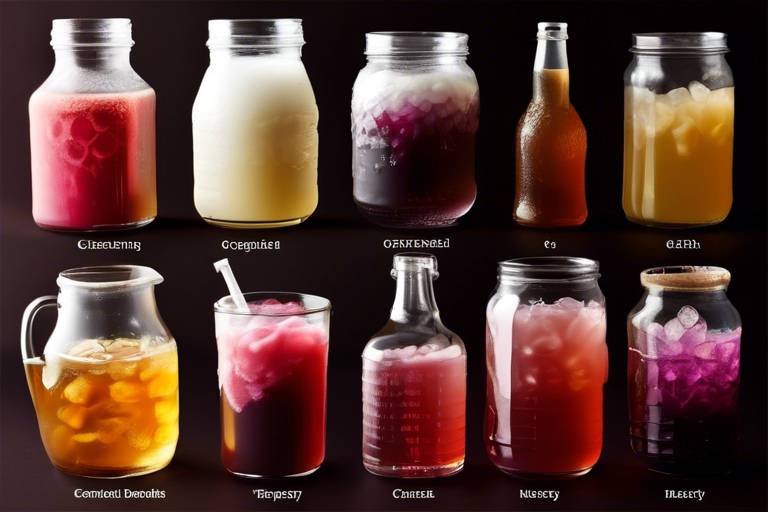The Science of Color - How It Affects Us Daily
Colors are not just visual phenomena; they are powerful tools that shape our experiences and emotions every single day. Imagine walking into a room painted in a vibrant yellow—instantly, you might feel a surge of energy and happiness. Now, contrast that with a space adorned in deep blue hues, where a sense of calmness and tranquility envelops you. This is the science of color, a fascinating field that explores how different shades impact our psychological state, influence our decisions, and even dictate our interactions with the world around us.
Have you ever noticed how certain colors can make you feel hungry? Think of the bright reds and yellows of fast-food chains that are designed to grab your attention and stimulate your appetite. Alternatively, consider the soft greens and browns used in wellness brands that evoke feelings of health and nature. This interplay between color and emotion is not just coincidental; it’s a carefully crafted strategy rooted in psychology and cultural significance.
Furthermore, the presence of color in our lives extends beyond just mood alterations. It plays a vital role in consumer behavior, influencing everything from the products we buy to the brands we trust. In a world saturated with choices, color can be a decisive factor that sways our preferences. For instance, have you ever wondered why tech companies often gravitate towards sleek blacks and blues? These colors convey sophistication and reliability, essential traits for brands in a competitive market.
As we delve deeper into the psychological impacts of color, we uncover a rich tapestry of associations that colors carry. Each hue tells a story, evoking memories and feelings that can vary significantly from person to person. This subjectivity adds layers of complexity to how we interpret colors in different contexts, whether it’s in marketing, art, or even our personal spaces. Understanding these nuances can empower us to make informed choices about our environments and the messages we convey through color.
In summary, the science of color is an intricate blend of psychology, culture, and human perception. By recognizing the profound effects colors have on our daily lives, we can harness their power to enhance our environments, influence our moods, and improve our overall well-being. So, next time you step into a room or encounter a brand, take a moment to notice the colors that surround you. They might just be speaking to you in ways you never realized!
- How do colors affect our emotions? Colors can evoke specific feelings and moods, such as warmth and happiness from yellows, or calmness and serenity from blues.
- Why are colors important in marketing? Colors influence consumer behavior by attracting attention, conveying brand messages, and creating emotional connections.
- What is the significance of color in different cultures? Colors can have various meanings across cultures, influencing traditions, art, and societal norms.
- Can color choices affect productivity? Yes, certain colors can enhance concentration and creativity, making them ideal for workspaces.

The Psychology of Color
Have you ever walked into a room and instantly felt a shift in your mood? This phenomenon isn't just a coincidence; it's the psychology of color at work. Colors have the remarkable ability to evoke emotions, influence perceptions, and even drive behaviors. Understanding how colors interact with our psyche can be a game-changer, whether you're designing a space, creating a marketing campaign, or simply choosing an outfit for the day.
Colors can be classified into various categories, each with its own emotional resonance. For instance, warm colors like red, orange, and yellow are often associated with feelings of warmth, excitement, and energy. They can stimulate feelings of passion and urgency, making them perfect for environments where you want to inspire action. On the flip side, cool colors such as blue, green, and purple tend to evoke calmness and tranquility. These colors can create a sense of peace and relaxation, making them ideal for spaces designed for rest and reflection.
Let’s take a moment to dive deeper into the emotional impacts of specific colors:
| Color | Emotional Impact |
|---|---|
| Red | Passion, energy, urgency |
| Blue | Calmness, trust, stability |
| Yellow | Happiness, optimism, attention |
| Green | Growth, harmony, freshness |
| Purple | Luxury, creativity, mystery |
In various settings, the intentional use of color can significantly impact decision-making processes. For instance, in a retail environment, a splash of red might catch a shopper's eye and encourage them to make a purchase, while a soothing blue might make them linger longer, creating a sense of trust and comfort. This is why many brands carefully select their color palettes to align with their values and the emotions they wish to evoke.
Moreover, cultural context plays a critical role in how we perceive colors. What might be considered a positive color in one culture could have negative connotations in another. For example, while white is often associated with purity and weddings in Western cultures, it can symbolize mourning in some Eastern cultures. This complexity adds an additional layer to the psychology of color, making it vital for marketers and designers to consider their audience's background.
In summary, the psychology of color is a fascinating interplay between emotion and perception. By understanding how different colors affect us, we can make more informed choices in our daily lives, whether it's creating a calming home environment, crafting an engaging advertisement, or simply expressing ourselves through fashion. So next time you choose a color, think about the feelings and messages it might convey. After all, colors are more than just visual elements; they are powerful tools that can shape our experiences and interactions.

Color in Marketing
Color is more than just a visual element; it’s a powerful tool that can influence consumer behavior and shape brand identity. When you think about it, have you ever walked into a store and felt instantly drawn to a particular product? That’s the magic of color at work. Companies invest a lot of time and money into understanding how different hues can evoke emotions and drive purchasing decisions. For instance, the color red can create a sense of urgency, which is why you often see it in clearance sales. On the other hand, blue is associated with trust and reliability, making it a popular choice for financial institutions.
Understanding the psychology behind color choices can help businesses craft marketing strategies that resonate with their target audience. A study conducted by the University of Loyola found that color increases brand recognition by a staggering 80%. This statistic alone highlights the importance of selecting the right colors in branding and advertising campaigns. But how do companies decide which colors to use? It often comes down to the emotions they want to evoke and the message they aim to convey.
To give you a clearer picture, let’s break down some common color associations and their implications in marketing strategies:
| Color | Associations | Common Uses |
|---|---|---|
| Red | Excitement, urgency, passion | Sales, clearance, food products |
| Blue | Trust, calmness, professionalism | Banking, healthcare, technology |
| Yellow | Optimism, happiness, attention-grabbing | Children's products, travel, food |
| Green | Health, tranquility, nature | Eco-friendly products, wellness brands |
| Purple | Luxe, creativity, wisdom | Beauty products, high-end brands |
As you can see, each color carries its own unique set of associations that can significantly impact consumer perceptions. When brands choose colors that align with their core values and target demographics, they not only enhance their visual identity but also create a deeper emotional connection with their audience. This is why you’ll often see companies like Coca-Cola using red to evoke excitement and energy, while Facebook uses blue to promote a sense of community and trust.
Moreover, the contrast between warm and cool colors can also be a deciding factor in marketing. Warm colors like red and orange can stimulate appetite and encourage impulse buying, while cool colors like blue and green tend to create a sense of calm that can lead to more thoughtful purchasing decisions. This interplay of colors is not just a matter of aesthetics; it's a deliberate strategy to influence consumer behavior.
In conclusion, the use of color in marketing is a complex yet fascinating aspect of consumer psychology. It’s a dance of emotions, perceptions, and strategic decisions that can make or break a brand’s success. So, the next time you find yourself drawn to a product, take a moment to consider the colors at play. They are not just there to look pretty; they are carefully chosen to evoke specific feelings and drive your decisions.
- Why is color important in marketing? Color can influence emotions and perceptions, leading to increased brand recognition and consumer trust.
- How do colors affect consumer behavior? Different colors evoke different emotions, which can impact purchasing decisions and brand loyalty.
- What are some examples of effective color usage in branding? Brands like Coca-Cola (red for excitement) and Facebook (blue for trust) effectively use color to align with their brand values.
- Can color choices vary by culture? Absolutely! Colors can have different meanings in different cultures, which is essential to consider in global marketing strategies.

Color Associations
Colors are not just mere visual stimuli; they carry a profound psychological weight that influences our emotions and behaviors in subtle yet powerful ways. For instance, when you see the color red, it might ignite feelings of passion or urgency, while blue often evokes a sense of calmness and serenity. These associations can vary based on personal experiences and cultural backgrounds, but there are some universally recognized meanings that marketers and designers leverage to their advantage.
Understanding color associations is crucial for anyone looking to communicate effectively through visual means. For example, brands often use specific colors to elicit desired responses from their audience. Here’s a brief overview of common color associations:
| Color | Common Associations |
|---|---|
| Red | Passion, Energy, Urgency |
| Blue | Trust, Calm, Stability |
| Green | Growth, Health, Nature |
| Yellow | Happiness, Optimism, Caution |
| Purple | Luxury, Creativity, Wisdom |
| Black | Power, Elegance, Mystery |
| White | Purity, Simplicity, Peace |
These associations are not just theoretical; they have real-world implications. For example, a brand that wants to convey a sense of trust and reliability might opt for a blue color scheme, while a company aiming to promote excitement and urgency might lean towards red. This strategic use of color helps businesses create a strong emotional connection with their audience.
Additionally, the context in which a color is used can significantly alter its meaning. For instance, while white is often associated with purity in Western cultures, it symbolizes mourning in some Eastern cultures. This cultural significance highlights the importance of understanding your audience when choosing colors for branding, marketing, or design.
In summary, the associations we have with colors are deeply ingrained in our psychology and culture. By harnessing these associations, brands can craft messages that resonate more effectively with their target audience. So, the next time you see a color, take a moment to consider what emotions or thoughts it might be evoking in you. It’s a fascinating interplay between color, perception, and behavior that shapes our daily experiences.
- What is the significance of color in marketing? Color plays a crucial role in attracting attention, conveying messages, and influencing consumer behavior.
- How do cultural differences affect color perception? Different cultures attribute various meanings to colors, which can influence how messages are received across different demographics.
- Can color affect mood and well-being? Yes, colors can evoke specific emotions and can be used in environments to enhance mood and promote well-being.

Warm vs. Cool Colors
When we think about color, it’s not just about what looks good—it's about how colors make us feel and the emotions they evoke. Warm colors, such as red, orange, and yellow, are often associated with feelings of excitement, energy, and warmth. Imagine walking into a room painted in vibrant oranges and reds; it’s like stepping into a cozy fire on a chilly night. These colors can stimulate feelings of enthusiasm and even increase heart rates, making them perfect for spaces where activity and interaction are encouraged, like a living room or a dining area.
On the other hand, cool colors like blue, green, and purple tend to bring a sense of calm and tranquility. Picture a serene blue sky or a lush green forest; these hues can evoke feelings of peace and relaxation. Cool colors are often used in spaces meant for rest and reflection, such as bedrooms or spa areas, where you want to unwind after a long day. They can also make a space feel larger and more open, which is why they are often favored in smaller rooms.
The contrast between warm and cool colors can be striking and is often used strategically in design. For instance, a room with warm accents can feel inviting and energetic, while cool tones can create a soothing ambiance. This duality allows designers to manipulate how we perceive a space, influencing our mood and behavior. It’s fascinating how a simple choice of color can transform a room from a lively gathering place to a tranquil retreat.
Here’s a quick breakdown of the effects of warm versus cool colors:
| Color Type | Examples | Emotional Impact | Best Used In |
|---|---|---|---|
| Warm Colors | Red, Orange, Yellow | Excitement, Energy, Warmth | Living Rooms, Dining Areas, Playrooms |
| Cool Colors | Blue, Green, Purple | Calmness, Relaxation, Serenity | Bedrooms, Offices, Spa Areas |
Ultimately, the choice between warm and cool colors comes down to the desired effect you want to achieve. Are you looking to create a lively space that encourages conversation and activity? Or do you want a serene environment where you can unwind and recharge? Understanding the psychological effects of these colors can help you make informed decisions, whether you’re decorating your home, designing a workspace, or even planning a marketing campaign. So, the next time you’re faced with a color choice, consider not just how it looks, but how it will make you—and others—feel.
- What are warm colors? Warm colors include red, orange, and yellow, and they evoke feelings of energy and excitement.
- What are cool colors? Cool colors consist of blue, green, and purple, promoting calmness and tranquility.
- How can color choices affect mood? Colors can significantly influence emotions; warm colors can energize, while cool colors can soothe.
- Where should I use warm colors in my home? Warm colors are best suited for social spaces like living rooms and dining areas.
- Where are cool colors most effective? Cool colors are ideal for bedrooms, offices, and relaxation spaces.

Color in Branding
When it comes to branding, color is not just a pretty hue; it’s a powerful tool that can make or break a company's identity. Think about it—when you see a bright red logo, what comes to mind? For many, it’s boldness, energy, and passion. This is no coincidence. Brands carefully select their colors to evoke specific emotions and create a lasting impression on consumers. In fact, studies suggest that up to 90% of snap judgments made about products can be based on color alone. Isn’t that fascinating?
Colors can convey a variety of messages without saying a single word. For instance, blue is often associated with trust and reliability, which is why many financial institutions, like banks and insurance companies, use it in their branding. On the other hand, green is synonymous with nature and health, making it a popular choice for organic and eco-friendly brands. The choice of color can even influence purchasing decisions, as consumers often prefer brands that resonate with their personal values and emotions.
The psychology behind color in branding can be broken down into a few key associations:
- Red: Excitement, passion, and urgency. Think sales and promotions!
- Blue: Trust, dependability, and calmness. Perfect for corporate brands.
- Green: Nature, health, and tranquility. Ideal for eco-conscious brands.
- Yellow: Optimism and warmth. Great for attracting attention.
- Purple: Luxury, creativity, and sophistication. Often used by beauty brands.
Moreover, consistency in color usage across all marketing materials helps to reinforce brand recognition. A consumer who sees a consistent color palette is more likely to remember the brand and its values. This is why companies invest heavily in color strategy, ensuring that every aspect of their branding—from their logo to their packaging—aligns with the emotions and messages they wish to convey.
To illustrate the impact of color in branding, consider the following table that showcases some well-known brands and their color choices:
| Brand | Primary Color | Emotional Association |
|---|---|---|
| Coca-Cola | Red | Excitement, Energy |
| Blue | Trust, Security | |
| Starbucks | Green | Health, Wellness |
| McDonald's | Yellow | Happiness, Warmth |
| Yahoo! | Purple | Creativity, Imagination |
In conclusion, the colors that brands choose are more than just aesthetic decisions; they are carefully calculated strategies aimed at influencing consumer perception and behavior. By understanding the emotional impact of color, businesses can align their branding efforts with their core values and resonate more deeply with their target audience. So, next time you see a brand, take a moment to consider the color choices they’ve made and the messages they’re trying to convey. It’s a world of meaning hidden in plain sight!
- Why is color important in branding?
Color is crucial because it influences emotions and perceptions, helping to create a strong brand identity. - Can color really affect consumer behavior?
Yes, studies show that color can significantly impact purchasing decisions and brand loyalty. - How do brands choose their colors?
Brands often conduct market research to understand their target audience’s preferences and the emotions associated with different colors. - Are there cultural differences in color perception?
Absolutely! Colors can have different meanings in different cultures, which brands must consider when marketing globally.

Color in Interior Design
When it comes to interior design, color is not just a superficial choice; it plays a pivotal role in shaping our living spaces and influencing our emotions. Imagine walking into a room painted in a soft, serene blue. Instantly, you feel a wave of calm wash over you. This is the power of color! It can transform a mundane space into a sanctuary, or a vibrant hub of energy, depending on the hues chosen. Understanding the psychological effects of color can help you create environments that not only look good but feel good.
Color can evoke a wide range of feelings and reactions, making it a crucial element in designing any space. For instance, warm colors such as red and orange are known to stimulate excitement and warmth, making them ideal for social areas like living rooms or kitchens where interaction is key. On the other hand, cool colors like blue and green can create a sense of tranquility and relaxation, perfect for bedrooms or meditation spaces. The right color palette can enhance the functionality of a room and improve the overall mood of its occupants.
Let's consider how different colors can impact specific areas in your home:
- Living Rooms: Warm tones create an inviting atmosphere, encouraging conversation and connection.
- Bedrooms: Soft blues and greens promote relaxation and restful sleep.
- Home Offices: A splash of yellow can inspire creativity, while neutral tones maintain focus.
Moreover, the lighting in a room can dramatically alter how colors are perceived. Natural light can make colors appear more vibrant, while artificial lighting can soften or change their appearance entirely. Therefore, when selecting colors for your space, it’s essential to consider the type of lighting you have and how it interacts with your chosen palette.
In addition to mood and functionality, color also plays a significant role in the visual coherence of a space. A well-thought-out color scheme can create a sense of flow and harmony throughout your home. For instance, using a consistent color palette across different rooms can tie your living space together, making it feel more cohesive. Conversely, clashing colors can create a sense of chaos and discomfort.
To illustrate the impact of color in interior design, consider the following table that summarizes common color effects:
| Color | Emotional Impact | Best Used In |
|---|---|---|
| Red | Excitement, Passion | Living Rooms, Dining Areas |
| Blue | Calmness, Trust | Bedrooms, Offices |
| Green | Balance, Growth | Bathrooms, Living Rooms |
| Yellow | Happiness, Energy | Kitchens, Playrooms |
| Purple | Luxury, Creativity | Art Studios, Bedrooms |
Ultimately, the colors you choose for your interior design should reflect your personality and lifestyle. Whether you prefer bold, vibrant hues or soft, muted tones, the key is to create a space that resonates with you and enhances your daily life. Remember, your home is a canvas, and color is the paint that brings it to life!
1. How do I choose the right color for my room?
Start by considering the mood you want to create. Research color psychology and test paint samples in your space to see how they look in different lighting.
2. Can I mix warm and cool colors?
Absolutely! Mixing warm and cool colors can create a dynamic look. Just ensure that they complement each other and maintain a cohesive theme.
3. How often should I change the colors in my home?
There's no set rule! It's a good idea to refresh your space every few years or whenever you feel your environment needs a change.
4. Are there colors that make a room look bigger?
Light colors, especially whites and pastels, can make a room feel larger and more open. Using mirrors can also enhance this effect.

Cultural Significance of Color
Colors are not just mere visual stimuli; they are deeply embedded in the fabric of our cultures and societies. The varies remarkably across different regions and communities, influencing everything from traditional ceremonies to everyday life. For instance, in Western cultures, the color white is often associated with purity and weddings, while in many Eastern cultures, it is linked to mourning and funerals. This duality highlights how colors can carry contrasting meanings based on cultural context.
Understanding these cultural nuances can provide valuable insights, especially in a globalized world where cross-cultural interactions are commonplace. Think about it: when you travel abroad or interact with people from different backgrounds, the colors you wear or use in design can send powerful messages. For example, red is a color of celebration and good fortune in China, often seen during festivals and weddings, whereas in South Africa, it can symbolize mourning. This rich tapestry of meanings makes color a fascinating subject to explore.
Moreover, colors can influence social norms and behaviors. In some cultures, specific colors are reserved for certain occasions. For instance, in India, the vibrant color yellow is often worn during the festival of Holi to symbolize joy and the arrival of spring. On the other hand, in many African cultures, colors like black and red are used in traditional attire to convey status and identity. This interplay between color and culture illustrates how deeply intertwined they are, shaping our perceptions and interactions.
To illustrate the cultural significance of color further, consider the following table that summarizes some common color associations across different cultures:
| Color | Western Culture | Eastern Culture | African Culture |
|---|---|---|---|
| Red | Love, Passion | Good Fortune | Mourning |
| White | Purity, Weddings | Mourning | Purity |
| Black | Mourning, Death | Power, Elegance | Death, Status |
| Yellow | Happiness, Caution | Joy, Spring | Wealth, Prosperity |
Colors also play a significant role in art and expression across cultures. Artists often draw upon the cultural meanings of colors to convey messages or evoke emotions. For example, a painting featuring dark hues might reflect themes of struggle or sorrow in one culture, while in another, it might symbolize strength and resilience. This ability to communicate complex ideas through color is what makes it such a powerful tool in artistic expression.
In conclusion, the is vast and varied. From influencing our daily choices to shaping our emotional responses, colors are a universal language that transcends borders. As we navigate through our multicultural world, being aware of these differences can enhance our interactions and enrich our understanding of the diverse tapestry of human experience.
- What does the color blue symbolize in different cultures? In many cultures, blue represents peace and tranquility. However, in some contexts, it can also symbolize sadness.
- Why is color important in branding? Color can evoke specific emotions and associations, helping brands to connect with their target audience and convey their identity effectively.
- How can I use color to enhance my home decor? Consider the mood you want to create; warm colors can energize a space, while cool colors can create a calming atmosphere.

Symbolism of Colors
Colors are not just visual experiences; they carry deep meanings and symbolisms that vary across different cultures and contexts. When we see a color, it often triggers a cascade of emotions and associations that can be both personal and collective. For instance, red may evoke feelings of passion or anger in one culture, while in another, it symbolizes luck and prosperity. This duality illustrates how colors are steeped in cultural significance and can influence our thoughts and actions in profound ways.
In many societies, colors have been linked to specific emotions and concepts, creating a rich tapestry of symbolism. For example, the color white is commonly associated with purity and innocence in Western cultures, while in some Eastern cultures, it represents mourning and death. This divergence shows that the interpretation of colors can be incredibly nuanced, shaped by historical, social, and environmental factors.
To better understand these associations, consider the following table that outlines common colors and their symbolic meanings across various cultures:
| Color | Western Meaning | Eastern Meaning |
|---|---|---|
| Red | Love, Passion | Luck, Happiness |
| Blue | Calm, Trust | Immortality, Spirituality |
| Green | Nature, Growth | Fertility, Prosperity |
| Yellow | Happiness, Energy | Deceit, Caution |
| Black | Power, Elegance | Mourning, Evil |
| White | Purity, Innocence | Mourning, Death |
Beyond cultural interpretations, colors also play a significant role in art and expression. Artists often use color to convey emotions, tell stories, and provoke thought. For instance, the use of vibrant colors can evoke feelings of joy and excitement, while muted tones might suggest melancholy or serenity. This relationship between color and emotion is not just limited to visual arts; it extends to literature, music, and even film, where color grading can dramatically alter the viewer's perception and emotional response.
Ultimately, understanding the allows us to navigate our world with greater awareness. Whether we are designing a marketing campaign, choosing an outfit, or decorating our homes, being mindful of color meanings can enhance our decision-making processes. It's fascinating to think that something as simple as a color can hold such power over our feelings and perceptions, shaping our experiences in ways we may not even realize.
- What does the color red symbolize? - Red often symbolizes love, passion, and energy but can also represent anger or danger depending on the context.
- How does color affect mood? - Colors can significantly influence our emotions; for example, warm colors like red and orange can create excitement, while cool colors like blue and green promote calmness.
- Are color meanings universal? - No, color meanings can vary widely across different cultures and contexts, making it essential to consider cultural backgrounds when interpreting colors.
- Can colors impact consumer behavior? - Absolutely! Businesses often use color strategically in branding and advertising to attract customers and convey specific messages.

Color in Art and Expression
Color is not just a visual element in art; it is a powerful language that artists use to convey emotions, tell stories, and create connections with their audience. When you walk into a gallery and see a painting bursting with vibrant reds and yellows, it’s not merely a feast for the eyes; it’s an invitation to feel something deep within. Artists intuitively understand that colors can evoke a spectrum of emotions, from joy to sorrow, and they wield this knowledge to enhance their expressions. For instance, consider how Vincent van Gogh used color in his famous work "Starry Night." The swirling blues and yellows create a sense of movement and emotion, drawing the viewer into a dreamlike state.
Moreover, color can also serve as a narrative device in art. Just as a writer chooses words to craft a story, an artist selects colors to shape their message. Think about how a warm, golden hue can symbolize warmth and comfort, while stark blacks and greys might convey despair or isolation. This interplay between color and meaning is what makes art so compelling and relatable. For example, in the realm of modern art, artists like Pablo Picasso often experimented with color to reflect different periods of his life, showcasing how color can represent personal experiences and emotions.
In addition to individual expression, color in art also has a cultural significance. Different cultures attribute various meanings to colors, which can influence how art is created and perceived. For instance, in many Eastern cultures, red is a symbol of luck and prosperity, while in Western cultures, it can signify danger or passion. This cultural lens adds another layer of depth to the understanding of color in art. Artists who are aware of these cultural associations can use them to resonate more deeply with their audience, creating a universal language that transcends borders.
To illustrate the emotional impact of color in art, consider the following table that outlines some common colors and their associated feelings:
| Color | Associated Feelings |
|---|---|
| Red | Passion, Energy, Anger |
| Blue | Calmness, Sadness, Trust |
| Yellow | Happiness, Optimism, Caution |
| Green | Growth, Harmony, Envy |
| Purple | Creativity, Luxury, Mystery |
When artists choose their palette, they are not just picking colors; they are selecting emotions, messages, and cultural narratives. This ability to connect with viewers on an emotional level is what makes art so powerful and timeless. Whether it’s a bold abstract piece or a delicate watercolor, the colors used can create an immediate impact, stirring feelings and sparking thoughts that linger long after the artwork is viewed. So, the next time you find yourself in front of a piece of art, take a moment to consider how the colors are speaking to you. What emotions do they evoke? What stories do they tell? It’s in this exploration that the true magic of color in art lies.
- How does color influence our emotions? Colors can evoke specific feelings and moods; for example, warm colors often stimulate feelings of warmth and excitement, while cool colors can promote tranquility.
- Why do artists choose certain colors? Artists select colors based on the emotions they wish to convey, cultural meanings, and personal experiences, creating a unique narrative through their work.
- Can color meanings vary between cultures? Yes, colors can have different meanings across cultures, affecting how art is interpreted globally.
- How can I use color in my own art? Experiment with different color palettes and consider the emotions you want to evoke. Study color theory to understand how colors interact and influence each other.
Frequently Asked Questions
- What is the psychology of color?
The psychology of color refers to how different colors can evoke specific emotions and influence perceptions. For instance, warm colors like red and yellow can create feelings of warmth and excitement, while cool colors like blue and green often promote calmness and serenity. Understanding this can help us make better choices in various aspects of life, from personal style to marketing strategies.
- How does color affect consumer behavior?
Color significantly impacts consumer behavior by influencing their emotions and decision-making processes. For example, brands often use red to create a sense of urgency, which can lead to impulse buying. Similarly, blue is frequently used to convey trust and reliability, making it a popular choice for financial institutions. By strategically using color, businesses can enhance their marketing effectiveness and draw in more customers.
- What are some common color associations?
Colors carry various associations that can differ by culture and context. For instance, green is often linked to nature and growth, while black may evoke feelings of elegance or mourning. Understanding these associations can help brands communicate their messages more effectively and resonate with their target audiences.
- How do warm and cool colors differ in their effects?
Warm colors, such as red, orange, and yellow, are known to evoke energy and excitement, making them great for stimulating conversation and activity. On the other hand, cool colors like blue, green, and purple tend to create a sense of calm and relaxation. This contrast can be essential when designing spaces or creating marketing materials, as the choice of color can set the tone for the viewer's experience.
- Why is color important in branding?
Color is crucial in branding because it helps convey a brand's identity and values. For example, a brand that uses green may be perceived as eco-friendly, while a brand that uses black might be seen as luxurious. The right color choice can strengthen brand recognition and influence consumer perceptions, making it a powerful tool in marketing.
- How can color impact interior design?
Color plays a vital role in interior design by affecting the mood and ambiance of a space. For instance, lighter colors can make a room feel more spacious and airy, while darker colors can create a cozy and intimate atmosphere. By thoughtfully selecting colors, designers can enhance the overall well-being and experience of the inhabitants.
- What cultural significance do colors hold?
Colors can have different meanings across cultures, influencing traditions, art, and societal norms. For example, white is often associated with purity in Western cultures, while in some Eastern cultures, it symbolizes mourning. Understanding these cultural significances can help in creating more inclusive and respectful designs and messages.
- How do artists use color for expression?
Artists utilize color as a fundamental tool for expression, using it to convey emotions and concepts within their works. The choice of color can dramatically alter the viewer's perception and emotional response. For example, a painting dominated by warm hues may evoke feelings of happiness and energy, while one filled with cooler tones might evoke tranquility or sadness.



















